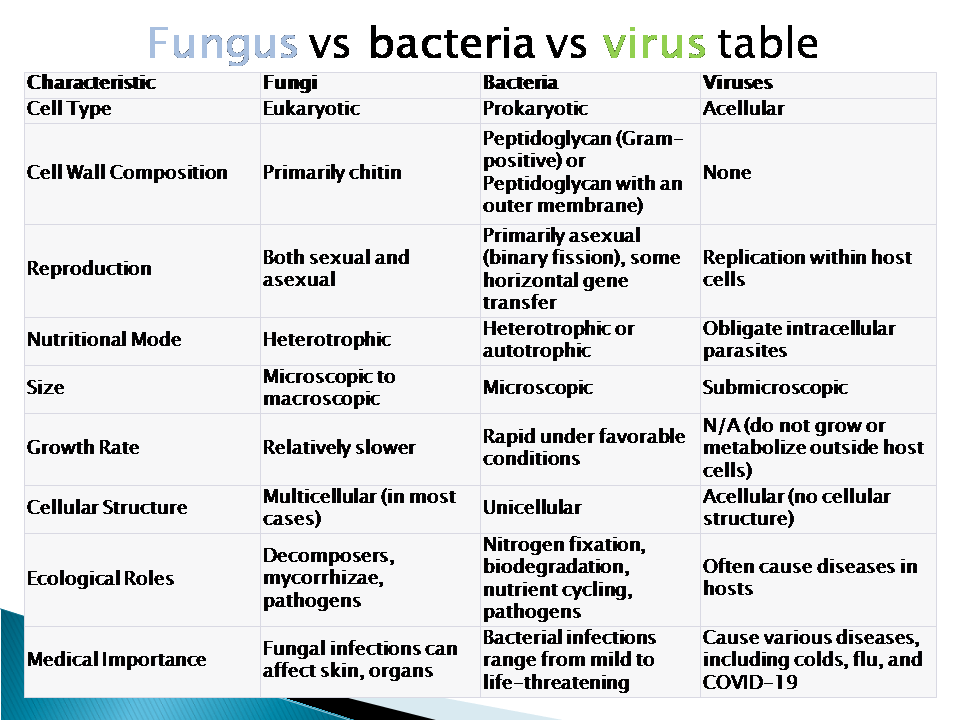Here you will learn about Fungus vs bacteria vs virus.

Microorganisms, though often invisible to the naked eye, play pivotal roles in the natural world and can significantly affect human health. Among these microorganisms, fungi, bacteria, and viruses are some of the most well-known and extensively studied.
Here are the differences and similarities between bacteria, viruses, and fungi.
Basics difference
Fungi:
Fungi are eukaryotic organisms, which means they possess a true nucleus enclosed within membranes. They are more complex than bacteria and viruses, often consisting of multicellular structures.
They can be found in various forms, including yeasts, molds, and mushrooms. They are primarily heterotrophic, obtaining nutrients by absorbing organic matter from their surroundings.
Bacteria:
Bacteria are prokaryotic microorganisms, meaning they lack a true nucleus and membrane-bound organelles. They are typically unicellular and come in a variety of shapes, including rods, spheres, and spirals.
They can be either heterotrophic or autotrophic and play vital roles in nutrient cycling, decomposition, and many other ecological processes.
Viruses:
Viruses are the simplest of the three and can’t be classified as cells. They are acellular, consisting of genetic material (either DNA or RNA) encased in a protein coat.
They cannot carry out metabolic processes on their own and must infect a host cell to replicate. They are essentially obligate intracellular parasites.
Structural Differences
Cell Wall Composition:
Fungi have rigid cell walls primarily made of chitin, a complex carbohydrate.
Bacteria have cell walls, too, but their composition differs. Gram-positive bacteria have a thick peptidoglycan layer, while Gram-negative bacteria have a thinner peptidoglycan layer surrounded by an outer membrane. Viruses, on the other hand, lack cell walls entirely.
Size:
Fungi are often larger than bacteria, with some fungal cells visible to the naked eye. Bacteria are typically measured in micrometers, making them much smaller. Viruses are even smaller, requiring specialized microscopes to observe.
Reproduction difference
Fungi: Fungi reproduce both sexually and asexually. They produce spores through sexual reproduction and can also reproduce by fragmentation, budding, or forming conidia.
Bacteria: Bacteria primarily reproduce asexually through a process called binary fission, where one cell splits into two identical daughter cells. Some bacteria can exchange genetic material through horizontal gene transfer.
Viruses: Viruses do not reproduce on their own. They inject their genetic material into a host cell and control the cell’s machinery to replicate themselves.
Ecological Roles
Fungi: Fungi are crucial decomposers, breaking down dead organic matter and recycling nutrients in ecosystems. They also form symbiotic relationships with plants (mycorrhizae) and can be either beneficial or harmful to humans.
Bacteria: Bacteria are involved in various ecological processes, such as nitrogen fixation, biodegradation, and nutrient cycling. Some bacteria are beneficial, like those in the human gut microbiota, while others can be harmful pathogens causing diseases.
Viruses: Viruses are unique in that they are not considered living organisms. They are obligate intracellular parasites that infect host cells, often causing diseases in humans, animals, and plants. However, some viruses have more benign interactions with their hosts.
Medical Importance
Fungi: Fungal infections, such as yeast infections and fungal skin conditions, are common in humans. Serious fungal infections can affect internal organs.
Bacteria: Bacterial infections can range from minor ailments like strep throat to life-threatening conditions like tuberculosis. Antibiotics are often used to treat bacterial infections.
Viruses: Viruses are responsible for a wide range of diseases, including the common cold, flu, HIV/AIDS, and more recently, the COVID-19 pandemic. Vaccines and antiviral medications are used to prevent and treat viral infections.
1 thought on “Fungus vs bacteria vs virus table”